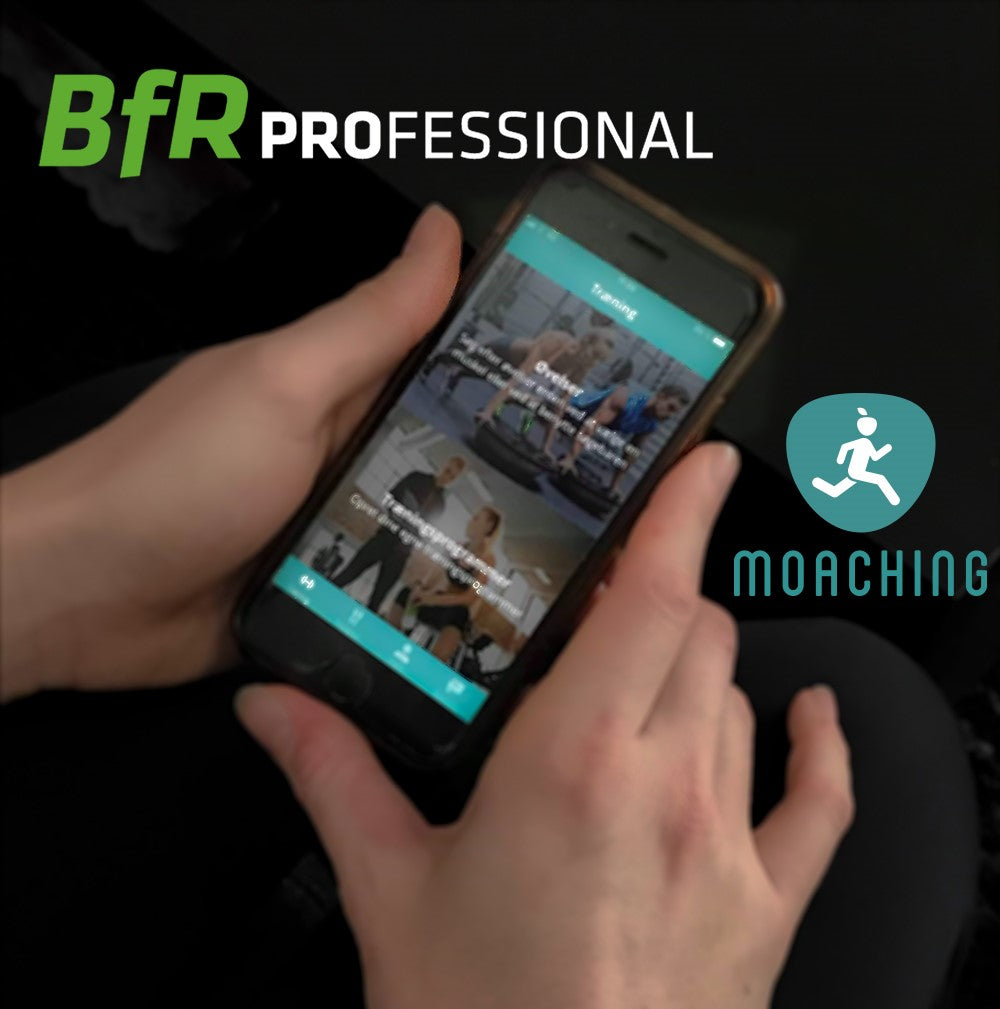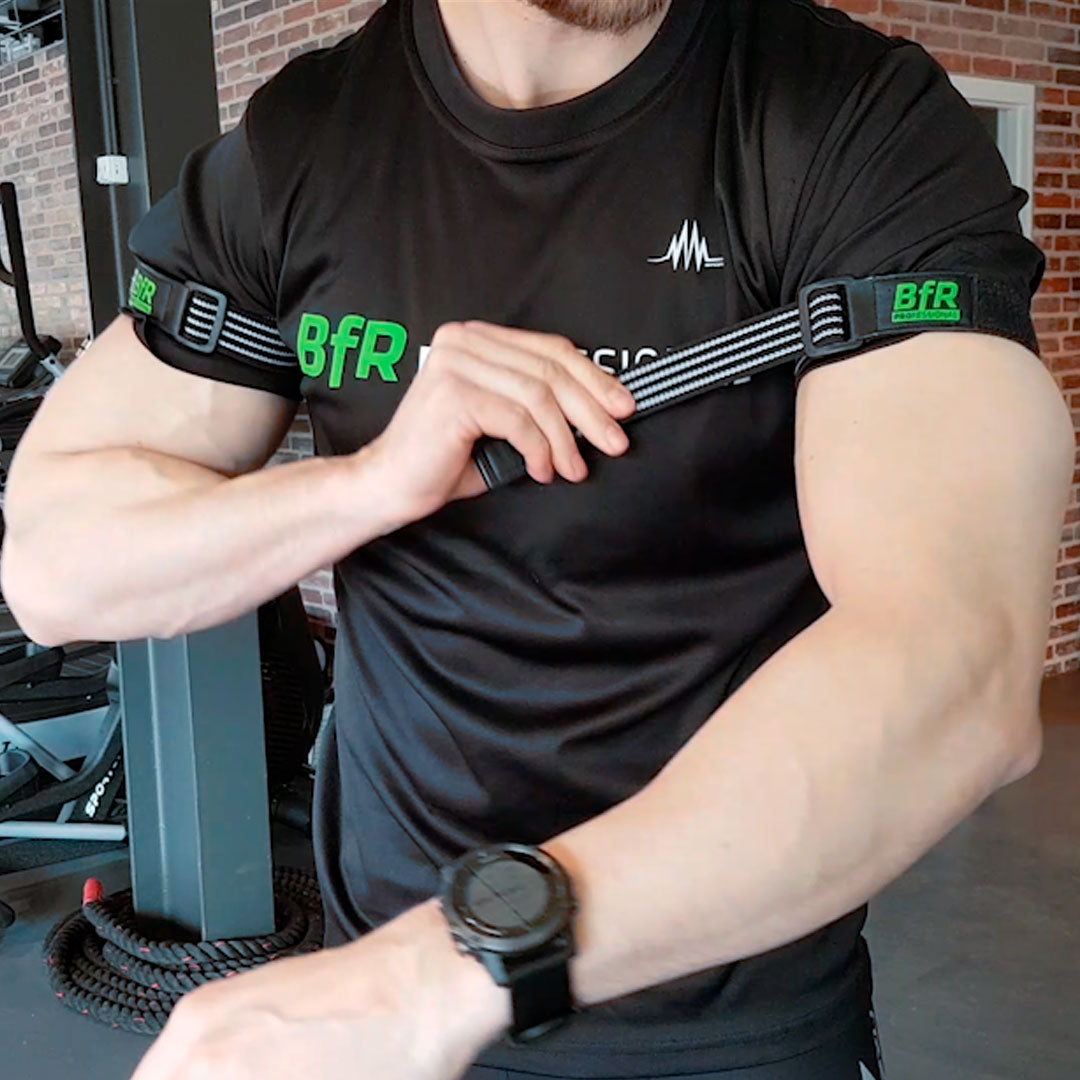
The Good Kind of Pain - A Study on BFR in Physiotherapy
In the spring of 2017, BfR Professional teamed up with two physiotherapist students focusing on the qualitative aspect of blood flow restriction training, and how people perceive the use of this still very new training method. Below you can read more about their interesting findings from their bachelor project.
Buckled up and ready for training
- A qualitative study based on interviews
By Højfeldt R. Jeanette, Jensen H. Pernille, BA. Physiotherapy, VIA University College Aarhus, Denmark.
Background and purpose
The project includes six participants. A physiotherapist, two patients with varying injuries and three self-trained subjects, one with an injury. In addition to using physiotherapists, all participants have been using blood flow restriction training in time periods spanning from three weeks to three months.
Results
The analysed data can be grouped into topics with key findings:
Application
Blood flow restriction training is versatile in its use and can, for instance, be used to max out in the last part of your session after high load training, or to prevent further pain from an injury during training. When tightening the band, some participants express a problem. They aren't sure whether the band is too tight or too loose, which is a common concern among the participants. This means that every individual has their own strategy to ensure the correct use, and therefore the tightening is self-perceived. Despite this issue, the band is reported easy to use:
Even though the band is tight, it gives the muscles room to expand during training.
Physical experience
A common experience is accelerated muscle atrophy compared to regular training. The participants observed visual changes in the veins, as these became more proinent and with a blue and red colour. This is an observation that the physiotherapist confirms. Another observation during training is a fast burning and a lactic feeling in the muscles. Several participants described blood flow restriction training as having a different feeling to its compared to regular training. The exhaustion was somehow different. One of the participants described the post experience like this:
Three out of six explain that blood flow restriction training has prevented pain from a current injury when training. One of them says that:
Back then, before I used the bands, I could barely do my exercises without feeling pain in my injury - I went home without working my muscles. It just hurt enormously.
Mental experience
The participants express great joy and satisfaction when using blood flow restriction training. Some mention that this kind of training is: fantastic, different, awesome, effective, a short and hard workout. In particular, they justify the relieving ability of the bands which causes the muscles to be stressed before the joint:
Just as annoying the soreness has been, it felt equally amazing - it's great because I feel alive.
Some of the participants report struggles with the low load training and motivation at the beginning:
At some points, it's demotivating not to have the usual kilos for someone who's used to training with a high load. But suddenly, I can take far more repetitions, and I came to notice that my legs become really tired, even without hurting the joints.
Among the participants, the feedback is an overall positive one concerning motivation for doing blood flow restriction training. For some, it was the applicability, for others, the competition and socialising.
Safety
The participants feel safe using blood flow restriction training. This is explained by the fact that they don't associate low load training with high risk of injury, despite tightening problems and a lack of knowledge:
I can go crazy while knowing I'm not going to break. I feel safe using it because I know the muscles get tired long before it ever gets dangerous for me.
Some of the participants report that the perception of safety is being created by the connection with the physiotherapist.
Conclusion
All participants found blood flow restriction training to be effective and said that it had a positive impact both physically and mentally. However, there is an issue with the subjective tightening of the bands, which requires more knowledge. The informants experienced a lactic and burning sensation, as well as an increased soreness, but this was not experienced as pain. This training method will suit both the elite and patients with injuries. However, consideration should be taken because blood flow restriction training can affect blood circulation.
Hope you enjoyed this read!
Team BfR Professional

What Happens Physiologically When You Do BFR Training?
By James Ruckley – Future Chiropractor & BfR Pro Ambassador UK
BFR training is a long-established training protocol combining the closing off a blood vessel and intense high rep training to alter the physiological environment in which a muscle is working. BFR is known by many names including occlusion training, vascular reduction (VR) and KAATSU training, so named by its inventor, Japanese Yoshiaki Sato.
It involves obstructing the venous system by using a form of compression to partially close a vein, reducing venous blood return to the heart altering the vascular system and bio-physiological chemistry of the muscles. BFR training should never impede the artery.
Tools for occlusion/BFR
The most common forms of compression used include knee wraps and KAATSU Cuffs, with the latter being considerably more scientific but expensive, or even the use of cut floss band to save on costs. The latter is however very uncomfortable, difficult to use and almost impossible to take off when your arms are weak and shivering. A fate I faced many times until BfR Professional came along and introduced their new velcro-based straps.
Easy to put on, comfortable and durable, the BfR Pro products allow full range of movement without shifting or impeding on the muscle. Once the working set is complete, their velcro design allows quick removal; a feature you'll only appreciate once you've trained this way!
The origin of BFR training
A bit more about BFR. It was discovered in 1966 by Dr. Yoshiaki Sato as an 18-year-old while he was attending a Buddhist festival. While kneeling, he suffered a reduction in blood flow to his calves leading to a painful increase in pressure in his lower limb muscles. Massaging them out he noted the similarity to that of a "pump" after an intense workout, including calf raises. He has since spent the about 50 years researching and perfecting his methods, tutoring and exploring new applications, gaining honorary degrees from the Medical Research Center at The University of Tokyo among others.
In that time, the training techniques and its application have developed rapidly, and it's now used in bodybuilding, rehab and medical interventions around the world. Similarly, the understanding of what mechanisms of change it creates within the body have developed in recent years allowing a more precise use of the technology, and it's now being used by many elite athletes and their coaches.
The slightly physio nerdy explanation of what's going on
Okay, here goes: By restricting the veins during muscular contraction, a number of changes happen. Blood is still able to enter the muscle supplied by the deeper laying arteries but unable to leave through the superficial veins. Because of this, an increase of pressure builds within the capillaries shunting hydrostatic fluids across endothelial membranes of the circulatory system and into the surrounding tissues, i.e. muscle fibers. This increase in fluids within the tissue draws nutrients from the blood vessel down a concentration gradient and into the tissue. Blood begins to pool in the veins while it backs up in the artery, decreasing flow as metabolites build up throughout the system.
The muscle swells as you actively contract it with the increased volume of each muscle fibre acting in the short term to increase strength. These already swollen fibres will continue to increase in size due to the hydrostatic pressures exerted by the artery until you either remove the venous block forcing them to either adapt and grow in size or burst. Since the intention of a resistance training is to damage muscle cells forcing them to repair and grow larger and stronger than before, this is a useful tool to consider when training.
Within these blood vessels, the endothelial cells react to the changing PH levels of the blood releasing an increased amount of Nitric Oxide. This chemical is found in most pre-workout formulas and marketed alone as a supplement used to increase the vasodilation of the vessels transporting blood to and from the muscles as well as giving you that "pumped" feeling. This is desirable for athletes as an increase in blood pressure directly raises the hydrostatic pressure and movement of fluids out of the blood and into the cells within the body. Similarly, Nitric Oxide has been shown to increase both permeability and elasticity of blood vessels when consumed or produced in higher quantities over extended periods of time maintaining vascular health.
With those extracellular changes occurring, it's no surprise to find that intracellular changes are abundant, too. Before we look into those, we must consider that muscle as a whole can be broken down into many levels with varying fibre types. There are 3 types of skeletal muscle fibre: Slow Twitch fibres (Type 1) are utilised by endurance athletes and can only function in the presence of oxygen. Fast Twitch Oxidative (Type 2a) are a much more explosive variety yet also utilise the oxidation of O2 to produce energy resulting in an explosive fibre with a resistance to fatigue in the medium term. The final fibre is Fast Twitch Glycolytic (Type 2b) which is only able to metabolise via the anaerobic glycolysis pathway without the use of O2. This drastically increases recovery time and reduces its ability to function beyond the most explosive of activities, i.e. intense weight lifting and sprinting.
During occlusion training, the Type 1 and 2a fibres are starved of oxygen decreasing their work capacity. This increases a neural stimulation to other fibres of the same type that may be inactive and increases motor recruitment. That is to say when we actively contract the muscle we only ever activate a percentage of its contained fibres. The percentage activated will vary from person to person but will never reach 100% of the muscle without external intervention from devices such as a Compex Muscle Stimulator which uses electrical impulses to stimulate 100% of motor units and in turn muscle fibres.
By activating more fibres through occlusion training, we are better able to train more of the muscle to the demands of our sports than we would likely be able to through standardised training alone. Once the Type 1 and 2a fibres are depleted and fatigued, we recruit Type 2b fibres to continue the exercise in the absence of oxygen.
This lack of oxygen creates a hypoxic environment within the tissue causing the release of Vascular Endothelial Growth Factor (VEGF). This signaling protein chemical is responsible for the creation of new blood vessels and their supporting networks. Blood vessels once complete will increase the surface area ratio of diffusion within the tissue allowing more oxygen and key nutrients to the tissue in the future along with increased lactate threshold.
With occlusion training reducing levels of oxygen available to working muscles, a lactic acid/lactate build-up occurs dramatically quicker than expected. This chemical soup build-up is counteracted by the body converting it back to pyruvate as previously mentioned. But with training, the body is better able to hold off and endure this acidic state for longer periods of time.
While more applicable for those completing High-Intensity Endurance Exercise (HIEE), the applications of occlusion training are useful for a variety of sports. Studies have shown that the change of intramuscular environment to an acidic state causes a vast increase in the release of Growth Hormones (GH), Myostatin (GD8), Heat Shock Protein (HSP) and Nitric Oxide Synthase-1, all of which are key regulators of hypertrophy and protein synthesis.
To sum up the benefits of BFR
With all that considered, it's clear that occlusion training should be a key technique in any athlete’s armory. However, it has one final trick up its sleeve. Occlusion training should be completed using only 20% of an individual’s 1 rep max and complete more repetitions per set, usually until failure. This reduced weight dramatically reduces the stress placed on joints which enables it to be used in rehabilitation or through minor injuries.
BFR training has been shown in research to effect:
- An increase in fluid volume within the muscle along with increasing nutrient uptake, strength and natural growth hormone.
- An increase in the body’s production of Nitric Oxide.
- An increase in motor unit activation and muscle fibre recruitment.
- An increase in VEGF leading to an increase in O2 delivery to tissue.
- A decrease in strain placed on joints and supporting tissue.
-
An increase in lactic acid/lactate production leading to:
- Lactate threshold improvement.
- Increased secretion of GH, Myostatin GD8, HSP and Nitric Oxide Synthesis leading to an increased rate of Hypertrophy.
- Plus, it can be used in recovery or rehab.
Can you really afford to ignore it?
*This is a slightly altered version for BfR readers. Read the full article and find the resources used at James's personal blog here.
We hope you found this useful,
Team BfR Professional








